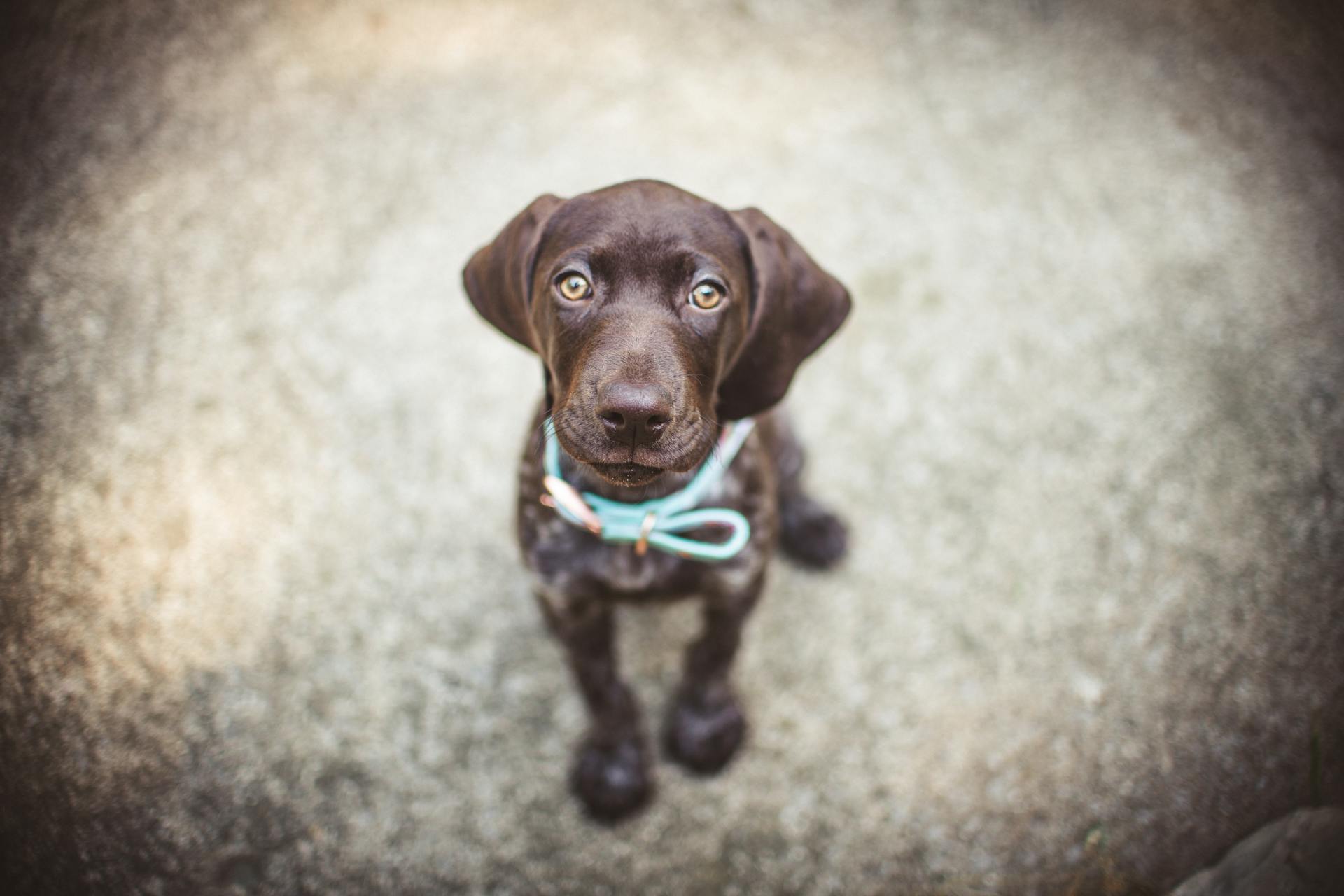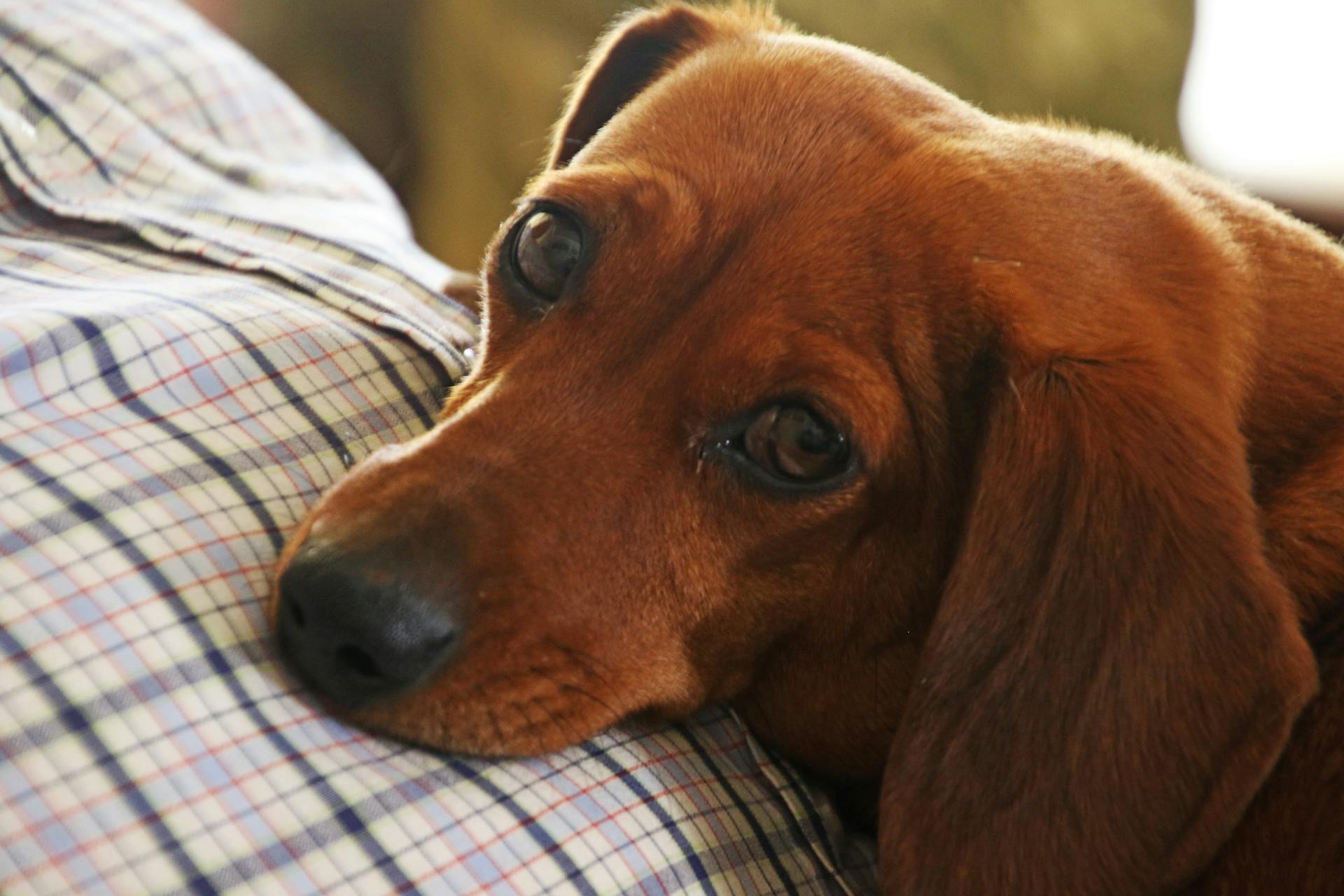
Dachshunds are prone to a condition that affects their backs, called Intervertebral Disk Disease. This condition occurs when the soft, gel-like center of the spinal disks bulges out through a tear in the outer layer.
Dachshunds are at risk due to their unique body shape, which puts extra pressure on their spine. Their long, narrow bodies and short legs make them more susceptible to back problems.
As a result, many Dachshunds will experience back pain and stiffness, especially in their neck and lower back.
What Is IVDD?
IVDD, or intervertebral disc disease, is a common condition that affects dachshunds and some other breeds with longer backs, impacting about 25% of them.
The condition occurs when the little discs between the vertebrae, which act as cushions, deteriorate and become susceptible to bulging or bursting, especially with hard impacts.
These discs are made of a jelly-like substance surrounded by cartilage, and when they deteriorate, they can rupture or bulge, putting pressure on the spinal cord.
For your interest: When Does a Female Dog Get Her First Period
IVDD can occur anywhere along the spine, and the rupture or bulge can affect either side of the spine, which can manifest as clinical signs being more "left-sided" or "right-sided".
The condition is most commonly noticed in dogs between ages 3 and 7, when they are most active in their lives.
There are two types of IVDD: Type 1, also known as a herniated or slipped disc, and Type 2, also known as a bulging disc, with Type 1 seen more often in small breed dogs with long backs and short legs.
About 65% of IVDD problems are associated with the thoracolumbar region of the spine, while about 18% are in the neck alone, with the rest being a combination of the two areas.
IVDD can cause pain, discomfort, loss of motor control, and complete paralysis in a matter of days following the injury, depending on how severe it is.
The gel-like core of the disc, called the nucleus pulposus, is like the filling of a "sandwich" formed by two cartilage ends, and when it ruptures or bulges, it can push up the delicate spinal cord, causing mild neurological signs or even acute paralysis.
For more insights, see: Early Signs of Ivdd in Dachshunds
Causes and Prevention
Preventing intervertebral disk disease in dachshunds can be challenging, but it's not impossible. Keeping your dog trim and fit is a great way to reduce the risk of injury.
Minimizing time spent going up and down stairs is also crucial, as this can put a lot of strain on your dog's back. Jumping on and off a deck, bed, or sofa should also be avoided.
Walking is a safe and enjoyable activity for dachshunds, while leaping for a thrown toy can be too much for their backs. If you notice any signs of back discomfort in your dog, contact your veterinarian right away.
Here are some tips to help prevent intervertebral disk disease:
- Keep your dog strong through regular exercise and a healthy diet.
- Avoid letting your dog do stairs, and instead use ramps or baby gates to block access.
- Use ramps for couches and beds to make it easier and safer for your dog to get on and off.
Most Common Source
The most common source of back pain in dogs is intervertebral disc disease (IVDD). This condition affects older dogs, but can also occur in younger dogs of predisposed breeds.
Intervertebral disc disease can cause a range of symptoms, from mild discomfort to paralysis. A dog with a spinal disc problem may avoid turning their head in one direction.

They may walk over to their food or water bowls, but then just look at them. However, if you lift one of the bowls up, they will likely eat or drink from that more comfortable position.
Intervertebral disc disease can cause a wobbly gait, making it appear as though your dog is battling weakness in the rear. In severe cases, your dog could be paralyzed, unable to get up or use their rear legs at all.
Your dog may also be incontinent due to this condition.
Recommended read: Rear Dew Claws on Dogs Breeds
Prevention
Prevention is key when it comes to avoiding spinal injuries in dogs. Keep your dog trim and fit to reduce the odds of an injury happening.
Minimize time spent going up and down stairs, and jumping on and off a deck, bed, or sofa, as these activities can put a lot of stress on your dog's back. Walking is a safe activity for any dog, but leaping for a thrown toy is not.
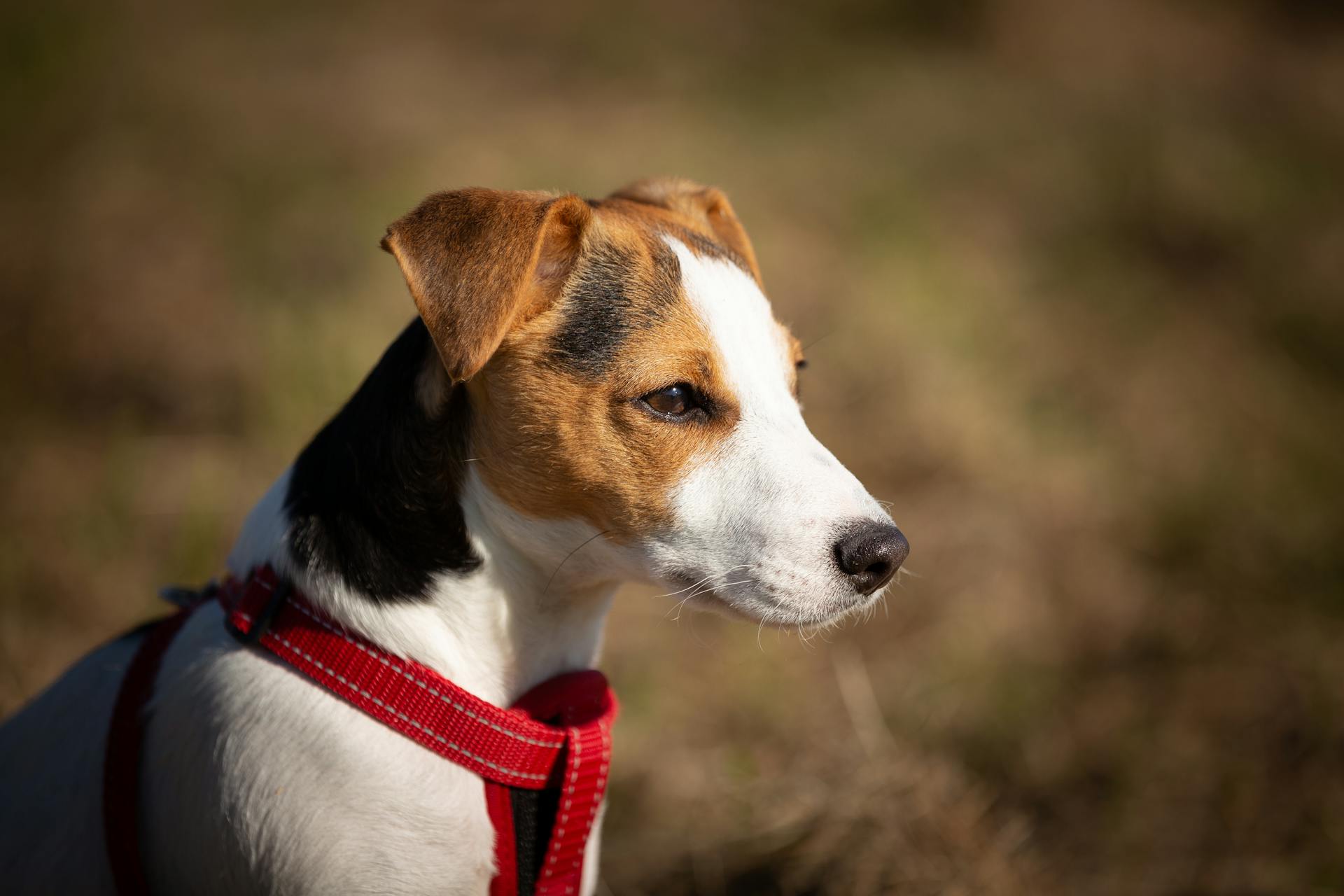
Plan sensible activities for your dog, taking into account their age, size, and fitness level. At the first sign of back discomfort, contact your veterinarian.
A strong back is less likely to be injured, so keep your dog strong with regular exercise and a healthy diet. A strong back also puts less stress on the discs themselves to absorb impacts.
Here are some specific tips to prevent spinal injuries:
- Don't let your dog do stairs! Baby gates can be set up at the top and bottom of all staircases to prevent accidents.
- Use ramps for couches and beds instead of making your dog jump up and down.
By following these simple tips, you can significantly reduce the risk of your dog suffering a spinal injury.
Diagnosis and Treatment
Diagnosis and treatment of intervertebral disk disease in dachshunds can be a complex process, but a veterinarian will use diagnostic imaging methods like x-rays, CT scans, or MRIs to pinpoint the affected area.
The goal of treatment is to relieve the compression of the spinal cord, which may involve surgery. Conservative medical management is also an option, which may include using steroids, strict cage rest, and pain management medications.
Your veterinarian will guide you on the best course of action based on the severity and duration of the clinical signs. The faster your dachshund gets treatment, the more likely they will be to recover.
You might enjoy: Ivdd in Dachshunds Treatment
Diagnosis and Treatment
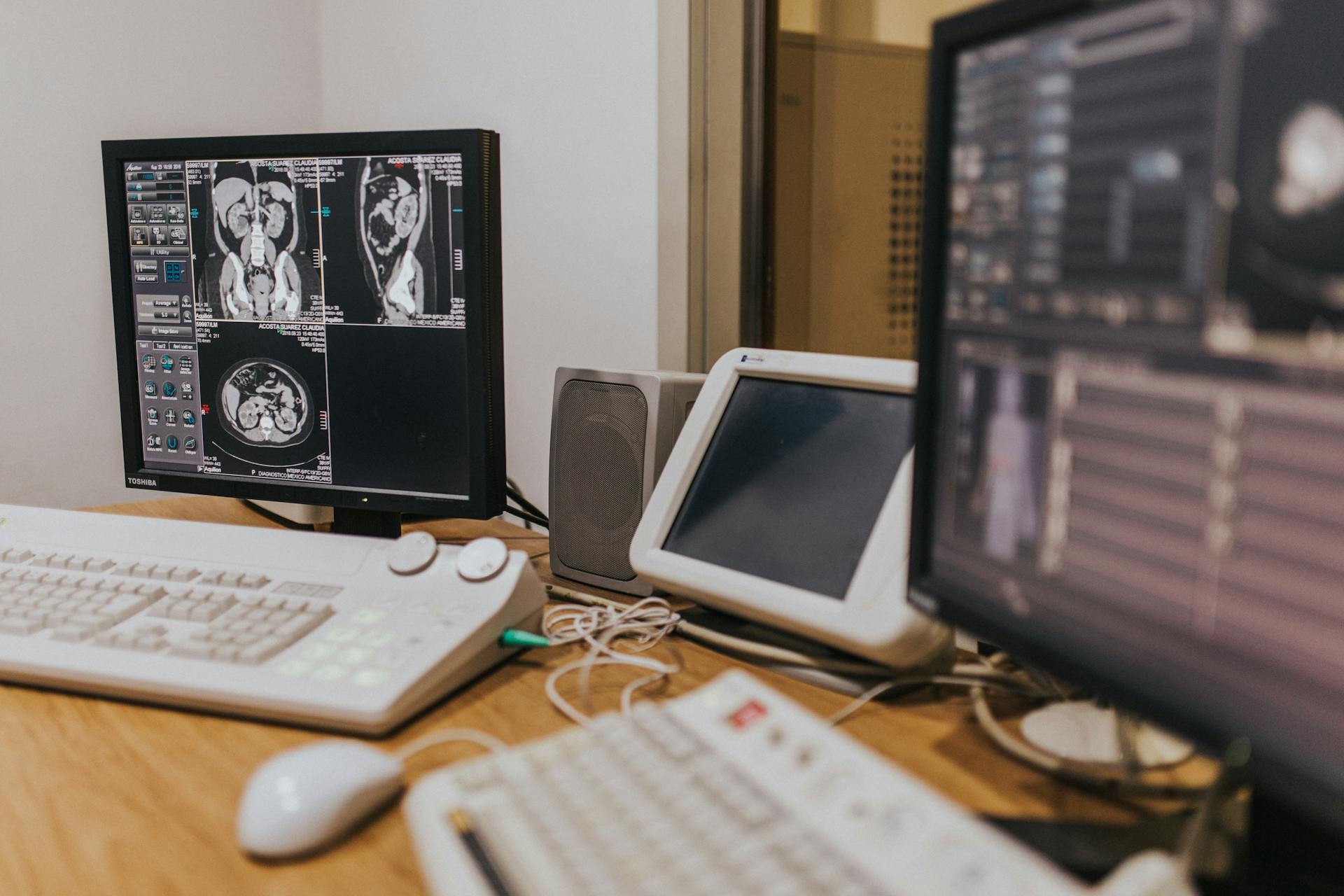
A thorough physical exam by your veterinarian is the first step in diagnosing IVDD. This is often all you need for a mild case.
Your veterinarian may use one or more diagnostic imaging methods, such as x-rays, CT scan, or MRI, to diagnose IVDD and pinpoint the location along the spine that is affected.
The goal of treatment is to relieve the compression of the spinal cord, which may include surgery or conservative medical management.
Conservative medical management may include use of steroids, strict cage rest, and pain management medications. Acupuncture and laser therapy can also be beneficial in IVDD case management.
If surgery is recommended, it's essential to act quickly, as the longer you wait, the greater the chance the spinal cord will degenerate to the point where it might not recover.
Your veterinarian can guide you to the best course of action for your pet depending on the severity and duration of the clinical signs.
Medications
Medications can play a crucial role in managing your dog's pain and inflammation after a disc episode or surgery.
Gebapentin, a very safe drug, is effective in treating nerve pain, as seen in Crusoe's case.
Anti-inflammatories are also necessary immediately following an episode or surgery to prevent further nerve constriction and pain.
Inflammation can worsen nerve pain, so it's essential to manage it promptly with anti-inflammatory medication.
Discover more: Healthy Mind Canine - Separation Anxiety Training
Table 4
Dogs with intervertebral disc calcification (IDC) are more likely to experience back pain, with 31% of dogs in the study population being affected. The frequency of back pain was positively associated with reluctance to jump onto a sofa.
A significant connection exists between IDC and IDD, with dogs having severe IDC (grade 3) experiencing frequent periods of pain. Dogs with IDC grade 3 had a strong association with back pain periods and reluctance to jump onto a sofa.
The table below highlights the effect of IDC grade on the frequency of various clinical signs in 193 Dachshunds radiographed for IDC:
Dogs with IDC grade 3 were more likely to experience back pain, with a 10.1 times higher odds ratio compared to dogs with no IDC.
Table 1

Let's take a closer look at the data from the study on intervertebral disc disease in Dachshunds.
The study involved a total of 193 Dachshunds, with a significant number of them being affected by the condition. In fact, 31% of the dogs had intervertebral disc disease (IDD).
The breed variants were also an interesting aspect of the study. The data shows that the Miniature wire-haired Dachshunds had the highest proportion of dogs with IDD, at 50%.
Here's a breakdown of the breed variant distribution and IDD status:
This data can be useful for breeders and owners to understand the risk factors associated with IDD in Dachshunds.
Table 2
Let's take a closer look at the data from Table 2, which breaks down the number of Dachshunds with intervertebral disc calcification grades 0-3 across three age groups.
The age group of 12-24 months had 30 dogs, with 14 (47%) having no calcifications (Grade 0).
In this age group, 10 dogs (33%) had 1-2 calcifications (Grade 1), 3 dogs (10%) had 3-4 calcifications (Grade 2), and 3 dogs (10%) had 5 or more calcifications (Grade 3).
The age group of 24-48 months had 114 dogs, with 16 (14%) having no calcifications (Grade 0).
This age group had a higher number of dogs with calcifications, with 49 (43%) having 1-2 calcifications (Grade 1), 22 (19%) having 3-4 calcifications (Grade 2), and 27 (24%) having 5 or more calcifications (Grade 3).
The age group of 48 months and older had 49 dogs, with 14 (29%) having no calcifications (Grade 0).
In this age group, 22 dogs (45%) had 1-2 calcifications (Grade 1), 4 dogs (8%) had 3-4 calcifications (Grade 2), and 9 dogs (18%) had 5 or more calcifications (Grade 3).
Here's a summary of the data from Table 2:
This data shows that the number of Dachshunds with intervertebral disc calcifications increases with age.
Managing IVDD
If your Dachshund is experiencing an IVDD episode, it's crucial to keep them immobile and visit your vet as soon as possible. They'll assess the situation and determine if the disc is pushing on the spinal cord, which could lead to permanent damage.
If your vet recommends surgery, it's essential to follow their post-operative instructions carefully, as the goal is to allow the disc to heal without causing further damage. This usually involves a 6-8 week period of healing and rehabilitation, with a mix of pain killers and anti-inflammatories, as well as laser therapy and acupuncture.
In the future, it's a good idea to follow precautions to prevent future IVDD episodes, such as keeping your Dachshund's weight in check and providing regular exercise and mental stimulation.
What Are Signs?
If your dog has IVDD, you might notice a range of symptoms, from a wobbly hind limb gait to complete paralysis of the hind limbs.
Back pain is often present, which can cause reluctance to move, crying or yelping when being moved or picked up, panting, or arching of the back.
In some cases, the dog may not have feeling in the hind limbs, making it difficult to determine the extent of the injury.
These symptoms can vary in severity depending on the type of IVDD and where it occurred, so it's essential to be aware of any changes in your dog's behavior or physical condition.
IVDD Episode? What Now?
If you suspect your dog is having an IVDD episode, it's essential to act quickly. Keep them immobile and in a crate right away to prevent further injury.
The first step is to assess the situation and determine the severity of the episode. Your vet will help you figure out if the disc is pushing on the spinal cord or not. If your dog is just showing pain but no loss of motor function, it could be a minor episode and not require surgery.
However, if your dog is down and not walking, surgery is the ideal option as soon as possible. You have 24 hours from the time they lose deep pain sensation in their toes, after which the dog may never walk again.
In either case, your vet will prescribe a mix of pain killers and anti-inflammatories to help manage your dog's pain and discomfort. You'll also need to follow a rehabilitation plan to aid in the healing process.
Here's a general outline of what you can expect:
- 6-8 weeks of crate-rest and controlled activity
- Laser therapy and acupuncture can be started right away
- Gradual introduction of exercise under the direction of a rehabilitation-specialized vet
- Scar tissue formation is crucial for healing, but too much inactivity can lead to muscle wasting
Remember, every dog is different, and recovery times will vary. But with the right care and attention, many dogs can make a full recovery and live happy, healthy lives. Even paralyzed dogs can thrive with the right support and equipment, like a wheelchair!
Methods
Managing IVDD requires a multi-faceted approach.
One key method is to maintain a healthy weight, as excess weight can put additional strain on the spine and worsen IVDD symptoms.
Broaden your view: Average Lifespan of a Dog by Weight
Regular exercise, such as short walks and gentle stretches, can help strengthen the muscles that support the spine.
Monitoring your dog's activity level and providing regular breaks can also help prevent further injury.
Limiting jumping and high-impact activities, such as playing fetch or going up and down stairs, can help alleviate pressure on the spine.
A well-balanced diet rich in omega-3 fatty acids, vitamins, and minerals can help promote overall spinal health.
A fresh viewpoint: Skin Care for Dogs with Allergies
Conclusions
Managing IVDD requires a comprehensive approach that involves a combination of preventative measures, early detection, and ongoing care.
Spinal injections can be a crucial part of managing IVDD, providing relief from pain and inflammation. This can be especially helpful for dogs with non-surgical cases of IVDD.
Dogs with IVDD need regular exercise and a healthy weight to reduce the risk of further injury. A daily walk of at least 30 minutes can help maintain a healthy weight and improve overall mobility.
A unique perspective: Do Male Dogs Gain Weight after Being Neutered
Physical therapy can also be an effective way to manage IVDD, helping to improve strength, flexibility, and mobility in dogs. This can be especially helpful for dogs that are recovering from surgery or have chronic IVDD.
A well-balanced diet is essential for maintaining a healthy weight and overall well-being in dogs with IVDD. A diet rich in omega-3 fatty acids and antioxidants can help reduce inflammation and promote healing.
Understanding the Disease
Intervertebral disk disease in dachshunds is a common issue, and understanding the disease is key to providing the best care for your furry friend.
Dachshunds are prone to this condition due to their unique body shape, which can cause their spines to be more susceptible to injury.
Their long, narrow bodies put a lot of pressure on their spines, making them more likely to develop intervertebral disk disease.
This condition occurs when the soft, gel-like center of the intervertebral disk bulges out through a tear in the outer ring, putting pressure on nearby nerves.
The symptoms of intervertebral disk disease can vary, but common signs include pain, stiffness, and difficulty walking.
For more insights, see: Most Common Dog Diseases
Background

Dachshunds are the breed most often affected by Intervertebral Disc Disease (IDD).
About 19-24% of Dachshunds will show clinical signs related to IDD during their lifetime.
In Finland, spinal radiography is used to screen for IDC, an indicator of severe IDD, before breeding Dachshunds.
Dachshunds have a hereditary background when it comes to IDD, making them more prone to the disease.
Intervertebral disc disease is a very common neurological disease, and Dachshunds are at a relative risk of 10-12 times higher than other breeds.
A study found that Dachshunds may be clinically affected by IDD as early as 3 to 6 years of age.
Signs & Symptoms
If your dog is whining, hiding under a bed, or squeals/whimpers when you pick them up, it could be a sign of a serious issue.
Pain is often the first clue that something is wrong. If your dog seems reluctant to move or is unwilling to stand up, that's another good indication.
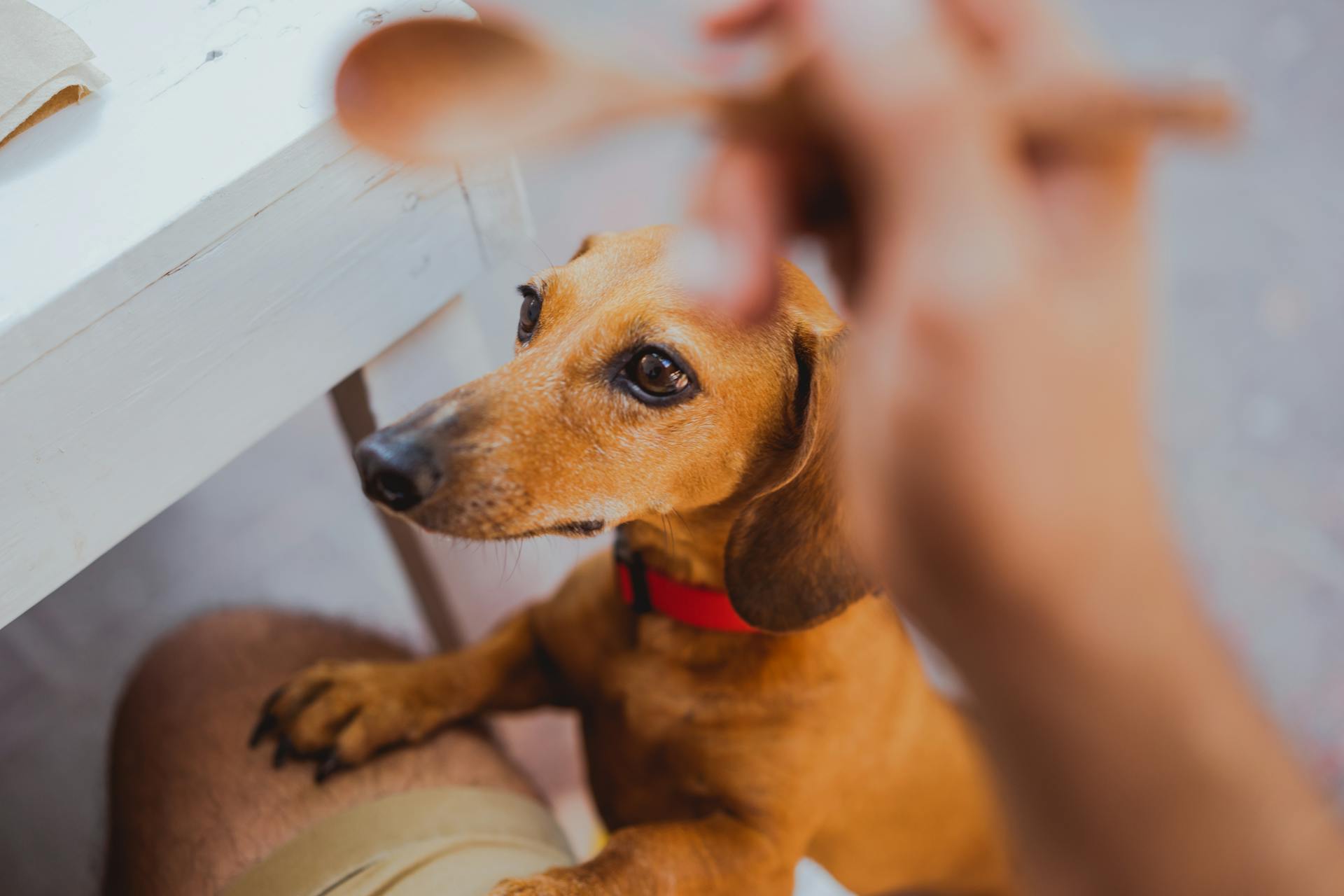
An arched back or head held high can be a sign of a problem with a disc in the neck. It's a subtle change, but one that's worth paying attention to.
Weakness or uncoordinated movement in the back legs is a more severe symptom. If your dog is having trouble moving around, it's essential to get them checked out.
Here are some common signs and symptoms to look out for:
- Pain: whining, hiding, squealing/whimpering when picked up
- Unwillingness to move
- Arched back or head held high (indicating a disc problem in the neck)
- Weakness or uncoordinated movement in the back legs
- Down dog (dragging/no control of back legs and bladder)
Research and Data
Intervertebral disk disease in dachshunds is a common condition, with studies suggesting that up to 25% of dachshunds will develop it by the age of 5.
The condition is more prevalent in dachshunds due to their unique body shape, which can cause their disks to degenerate faster.
The typical age of onset for intervertebral disk disease in dachshunds is between 4 to 10 years old.
The condition can cause a range of symptoms, from mild to severe, including back pain, paralysis, and even incontinence.
One study found that the majority of dachshunds with intervertebral disk disease will experience some form of back pain.
The condition is often diagnosed through a combination of physical examination, imaging studies, and a review of the dog's medical history.
The prognosis for dachshunds with intervertebral disk disease varies depending on the severity of the condition and the promptness of treatment.
In some cases, surgery may be necessary to relieve pressure on the spinal cord and prevent further damage.
Frequently Asked Questions
What are the first signs of IVDD in Dachshunds?
Back pain and reluctance to jump or climb stairs are common first signs of IVDD in Dachshunds, often accompanied by a hunched posture or sensitivity along the spine
What is the life expectancy of a dog with intervertebral disc disease?
The life expectancy of a dog with intervertebral disc disease varies depending on several factors, but with proper care, many dogs can live fulfilling lives. Prognosis depends on the severity of the condition, age, and overall health.
What age is IVDD most common in Dachshunds?
IVDD is most common in Dachshunds between the ages of 5 and 14, with 40% of dogs in this age range experiencing some degree of the condition.
Sources
- https://www.vet.cornell.edu/departments-centers-and-institutes/riney-canine-health-center/canine-health-information/intervertebral-disc-disease
- https://www.ncbi.nlm.nih.gov/pmc/articles/PMC4285634/
- https://celebritydachshund.com/pages/intervertebral-disc-disease-ivdd-in-dachshunds
- https://cgejournal.biomedcentral.com/articles/10.1186/s40575-016-0039-8
- https://www.pawsitivestepsrehab.com/blog/ivdd-a-dachshunds-tale/
Featured Images: pexels.com
